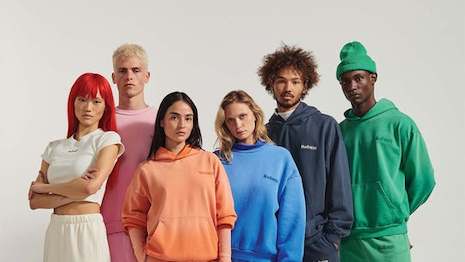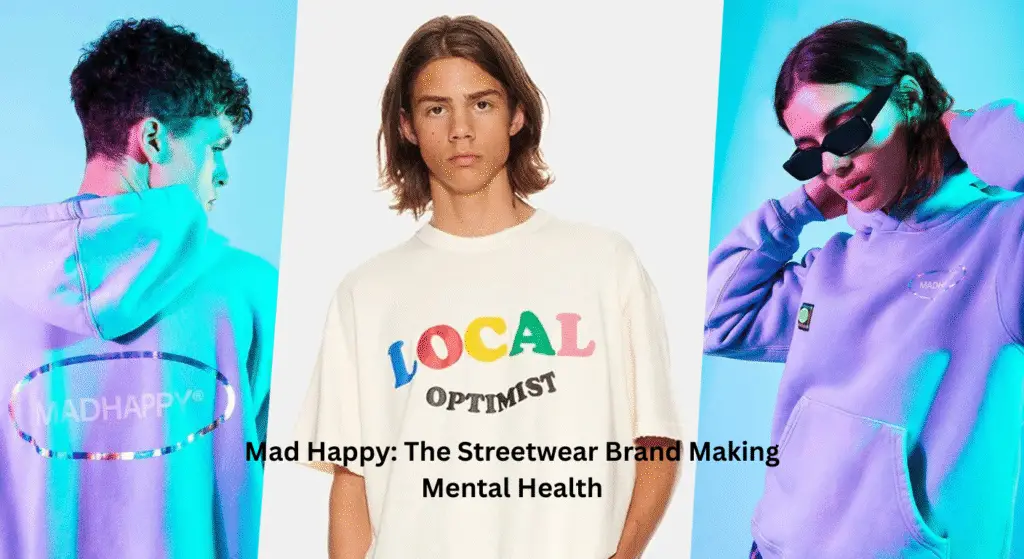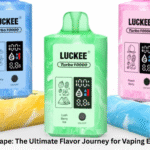In the increasingly saturated world of streetwear, where hype often trumps meaning and logos speak louder than purpose, Mad Happy emerges as an outlier—a brand that refuses to be just about appearances. More than just another drop-hungry label riding the wave of limited releases and celebrity co-signs, Mad Happy is a cultural movement rooted in emotional authenticity, mental health advocacy, and an unwavering commitment to community. Since its inception, Mad Happy has redefined what it means to be a modern fashion label, where style and substance meet on equal terms. In this deep dive, we’ll explore the origins, philosophy, design language, cultural impact, and future trajectory of one of the most emotionally resonant streetwear brands of our time.
The Genesis of Mad Happy: From Idea to Identity
Mad Happy was born in 2017 out of an instinctive need to fill a void in the fashion space—not for more clothes, but for more conversation. Co-founded by Peiman Raf and Noah Raf (brothers), along with Josh Sitt and Mason Spector, the brand was initially conceived not just as a business venture, but as a form of social expression. The name “Mad Happy” itself encapsulates the duality of the human emotional experience—how one can simultaneously experience a spectrum of emotions, even contradictory ones.
The founders, who each had their mental health journeys, understood that vulnerability had a place in public life and that clothing could serve as a canvas for those ideas. In their early days, the team took to the streets of Los Angeles with nothing more than a few hoodie samples and a deep belief in their message. What followed was an organic growth pattern rarely seen in the fashion industry: a community that formed around authenticity rather than trend-chasing, substance over spectacle.
Designing for Emotion: More Than Just Merch
Mad Happy’s design language is clean but powerful, minimalist yet emotionally complex. Unlike other streetwear brands that rely heavily on heavy graphics or loud branding, Mad Happy often opts for carefully curated color palettes and understated typography that communicates sincerity. Their garments are comfortable, cozy, and purposefully approachable—meant to be worn every day and lived in, not just flexed on Instagram.
Collections often feature mantras and affirmations stitched or printed across hoodies, sweatpants, tees, and caps: “Local Optimist,” “Mental Health Is Health,” or simply “Mad Happy.” These aren’t just slogans—they’re conversation starters. The typography and layout feel intentional, akin to reading a diary entry or a post-it note of encouragement stuck to your mirror. Colors are often selected with psychological impact in mind—pastels and warm tones that evoke calm, happiness, and safety. It’s fashion with an emotional IQ.
The Mental Health Mission: Changing the Dialogue
Perhaps the most groundbreaking element of Mad Happy is its core mission to destigmatize mental health. Long before corporations and brands began championing mental wellness as a trend, Mad Happy was having those uncomfortable yet vital conversations. This wasn’t opportunism—it was authenticity.
In 2020, the brand formalized this commitment by launching The Mad Happy Foundation, a nonprofit that directly funds mental health programs, resources, and research. Through partnerships with organizations such as The Jed Foundation and Project Healthy Minds, the foundation supports initiatives that range from youth therapy access to digital mental health education. This isn’t just about writing checks—it’s about reshaping the very way people think and talk about mental health.
Mad Happy also produces a weekly newsletter and podcast that features mental health professionals, artists, athletes, and community members discussing their experiences with mental wellness. It’s a multi-platform effort to normalize the conversation and give people tools to navigate their mental landscape.
The Retail Experience: Physical Spaces With Emotional Depth
While most streetwear brands rely heavily on online hype or pop-up culture, Madhappy has invested significantly in physical retail spaces that double as immersive experiences. Their pop-ups and flagship stores are thoughtfully designed—not just to sell apparel but to evoke emotional connectivity. From calming music to sensory-driven design elements, stepping into a Mad Happy store often feels like walking into a therapeutic retreat.
One of their most iconic retail activations was the “The Local Optimist” pop-up, which functioned as part art gallery, part clothing shop, and part community center. Visitors could journal, attend group discussions, or just sit in a calming space designed to promote mindfulness. This fusion of retail and wellness is emblematic of Mad Happy’s broader strategy: use fashion as a foot in the door to deeper conversations.
Community as Cornerstone: Not Just Consumers, but Collaborators
Community is not a buzzword for Mad Happy—it’s a cornerstone of their ethos. Rather than building a traditional customer base, the brand has cultivated a community of emotionally invested individuals who see themselves as part of a broader movement. This community isn’t passive; it’s engaged, expressive, and often instrumental in shaping the brand’s direction.
From social media campaigns where followers share their mental health journeys, to interactive events and collaborations with therapists and educators, Mad Happy ensures that the community isn’t just heard but valued. Their content is often user-generated or features real stories from fans, blurring the line between brand and audience. In doing so, Mad Happy has turned streetwear from a status symbol into a support system.
Collaborations With Purpose: Aligning Values Over Hype
In the realm of fashion, collaborations are often nothing more than clout chases—limited runs designed to inflate demand and pad bottom lines. Mad Happy, however, approaches collaborations with surgical precision, ensuring that every partnership aligns with their values and expands their mission.
Notable collaborations have included projects with Columbia Sportswear for performance-meets-purpose gear, LVMH for broader visibility, and even Apple to create mindfulness-forward digital wellness initiatives. Each collaboration is less about merging logos and more about merging missions. Whether it’s introducing mental health resources into unexpected sectors or simply broadening their emotional design language, these partnerships are always aligned with Mad Happy’s north star: making people feel seen, heard, and supported.
Cultural Impact: Redefining Cool in the Era of Conscious Consumption
In a world where “cool” has often been synonymous with aloofness or detachment, Mad Happy is rewriting the script. Vulnerability is the new flex. Optimism is the new rebellion. The brand’s cultural resonance lies not in celebrity endorsements or viral marketing tactics, but in its ability to reflect the emotional state of an entire generation.
Today’s youth are more introspective, more digitally connected yet emotionally complex, and increasingly wary of superficiality. Mad Happy meets them where they are—with content, clothing, and community that speaks their emotional language. Celebrities like LeBron James, Gigi Hadid, and Jay-Z have been spotted in Mad Happy gear, but it’s the brand’s emotional integrity, not the clothes, t—that draws them in.
The Business Behind the Brand: A Model of Sustainable Growth
Unlike many startups that burn bright and fast, Mad Happy has adopted a slow-burn approach to growth. With careful scaling, limited drops, and intentional partnerships, the brand has built a sustainable business model rooted in quality over quantity. Their limited-run collections keep demand high without overextending supply chains, while their direct-to-consumer model preserves brand intimacy and control.
Investors have taken notice, with LVMH’s Ventures arm among those backing the company. But even with financial backing, Mad Happy has resisted the urge to flood the market. Their growth feels patient, purposeful, and above all, personal.
The Road Ahead: What’s Next for Mad Happy?
As the brand moves forward, its biggest challenge might not be maintaining relevance, but preserving its soul. Growth often comes with pressure to conform, to standardize, to prioritize profit over purpose. Yet if Mad Happy continues to anchor its expansion in its foundational mission—authentic emotional storytelling, community-centered design, and mental health advocacy—it’s poised to become more than just a brand. It could become a generational institution. Plans include expanding their mental health resources, increasing accessibility to their apparel through inclusive sizing and pricing, and potentially opening more permanent retail locations globally. There’s also room for expansion into adjacent categories—think wellness tech, educational platforms, and even mental health-first physical spaces like cafes or co-working areas.
Final Thoughts: Mad Happy as a Mirror of Modern Humanity
Madhappy Hoodie isn’t just a clothing brand—it’s a mirror. It reflects the reality that life is messy, emotions are layered, and being human means living in the gray areas. By embracing the contradictions of joy and sadness, strength and vulnerability, it challenges us to think differently about what we wear and why we wear it.
In an era where superficiality is easy to manufacture and harder to escape, Mad Happy offers something that feels rare: sincerity. It’s the kind of brand that doesn’t just occupy closet space—it occupies headspace. And that, in today’s world, is perhaps the most valuable real estate of all.


